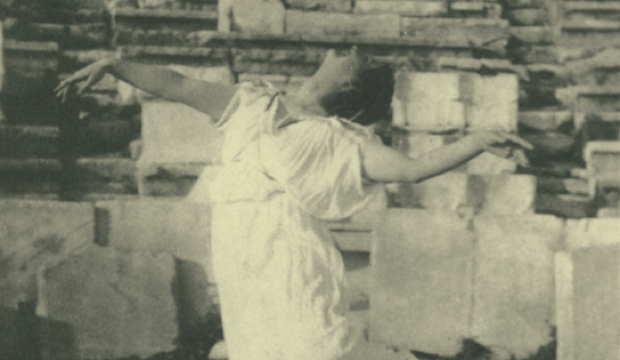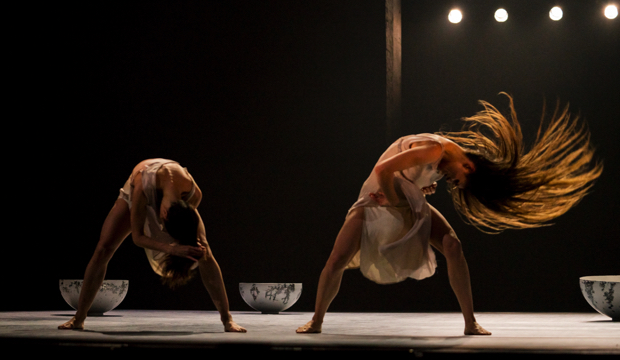Viviana Durante Company, Isadora Now review ★★★★★
Isadora Duncan, known as 'the mother of modern dance', is celebrated in a new triple bill at the Barbican: Viviana Durante Company’s Isadora Now
Viviana Durante Company, Isadora Now, Five Waltzes in the Manner of Isadora Duncan, dancer Begoña Cao, image David Scheinman
A woman lies on her side. She wears a ruched salmon-coloured Greek tunic, her legs and feet are bare. Teased by the notes cascading from the piano, she smiles and lazily moves one arm. Her hand caresses the ground as if playing with sand. She rises. And then she dances.
Thus begins Five Brahms Waltzes in the Manner of Isadora Duncan, by the British choreographer Frederick Ashton, who saw Isadora dance and was deeply affected and inspired by her radical concept of movement.
Ashton’s short work forms the centrepiece – and very much the highlight – of Isadora Now, Viviana Durante Company’s homage to the American pioneer of modern dance.
Isadora Duncan (1877-1927) was a true free spirit. Inspired by the ideals of ancient Greece, she swapped the corsets and strictures of classical ballet for flowing Greek tunics and light sandals or bare feet. She developed a new style of movement that reflected the impulses of nature, such as the sea and the wind.

Isadora Duncan dancing in the Theatre of Dionysus by Raymond Duncan (1903). Photo: Jerome Robbins Dance Division, The New York Library for the Performing Arts
Isadora Duncan championed women’s rights and lived her life on her own terms, regardless of social conventions. Acclaimed and condemned in equal measure, she simply couldn’t be ignored.
Ashton captured the joy of freedom and the sheer exultation of the body that characterised Duncan’s expansive moment. And in Isadora Now the ballerina Begoña Cao (replacing an injured Viviana Durante, in what was to be her first solo performance in 10 years), is arresting as she flows and skips, now earthy, now airy, now pensive, now recklessly chasing the wind, trailing an undulating silk wrap.
Intensely musical, Cao was at one with Brahms’ music, played live on stage by Anna Geniushene. It was an exhilarating 10 minutes.
The triple bill started with one of the few extant Duncan works, Dance of the Furies, which she created for a 1911 performance of Gluck’s Orphée et Eurydice at the Théâtre du Châtelet, Paris.
Danced by five women to an old, deliberately scratchy recording of Gluck’s opera, this is a fascinating piece: the movement, at first furtive, slowly developing into a frenzied ritual, is not pretty, nor is it meant to be. These are demonic furies, and Duncan intended them to convey darkness and evil through violent gesture and grimace.
After the interval there came Unda, a piece for the entire ensemble of six women in dun-coloured tunics, by the young dancer and choreographer Joy Alpuerto Ritter, to original music by Lih Qun Wong, performed live on stage on cello and computer.

Viviana Durante Company, Isadora Now, Unda, company. Photo: David Scheinman
Intended as a projection of Isadora for our times, Unda is mostly unfathomable, burdened with too much concept, an attempt to cram too many influences into a single work. And although it’s only 40 minutes long, it goes on a lot longer than it holds your interest.
That said, Viviana Durante Company’s Isadora Now, co-produced with the Barbican, is a fascinating project, an intelligent and emotion-laden homage to a woman who changed the face of dance for ever.
Age Guidance: 8+
Post-show talk (free to same-day ticket holders): 27 February
Thus begins Five Brahms Waltzes in the Manner of Isadora Duncan, by the British choreographer Frederick Ashton, who saw Isadora dance and was deeply affected and inspired by her radical concept of movement.
Ashton’s short work forms the centrepiece – and very much the highlight – of Isadora Now, Viviana Durante Company’s homage to the American pioneer of modern dance.
Isadora Duncan (1877-1927) was a true free spirit. Inspired by the ideals of ancient Greece, she swapped the corsets and strictures of classical ballet for flowing Greek tunics and light sandals or bare feet. She developed a new style of movement that reflected the impulses of nature, such as the sea and the wind.

Isadora Duncan dancing in the Theatre of Dionysus by Raymond Duncan (1903). Photo: Jerome Robbins Dance Division, The New York Library for the Performing Arts
Isadora Duncan championed women’s rights and lived her life on her own terms, regardless of social conventions. Acclaimed and condemned in equal measure, she simply couldn’t be ignored.
Ashton captured the joy of freedom and the sheer exultation of the body that characterised Duncan’s expansive moment. And in Isadora Now the ballerina Begoña Cao (replacing an injured Viviana Durante, in what was to be her first solo performance in 10 years), is arresting as she flows and skips, now earthy, now airy, now pensive, now recklessly chasing the wind, trailing an undulating silk wrap.
Intensely musical, Cao was at one with Brahms’ music, played live on stage by Anna Geniushene. It was an exhilarating 10 minutes.
The triple bill started with one of the few extant Duncan works, Dance of the Furies, which she created for a 1911 performance of Gluck’s Orphée et Eurydice at the Théâtre du Châtelet, Paris.
Danced by five women to an old, deliberately scratchy recording of Gluck’s opera, this is a fascinating piece: the movement, at first furtive, slowly developing into a frenzied ritual, is not pretty, nor is it meant to be. These are demonic furies, and Duncan intended them to convey darkness and evil through violent gesture and grimace.
After the interval there came Unda, a piece for the entire ensemble of six women in dun-coloured tunics, by the young dancer and choreographer Joy Alpuerto Ritter, to original music by Lih Qun Wong, performed live on stage on cello and computer.

Viviana Durante Company, Isadora Now, Unda, company. Photo: David Scheinman
Intended as a projection of Isadora for our times, Unda is mostly unfathomable, burdened with too much concept, an attempt to cram too many influences into a single work. And although it’s only 40 minutes long, it goes on a lot longer than it holds your interest.
That said, Viviana Durante Company’s Isadora Now, co-produced with the Barbican, is a fascinating project, an intelligent and emotion-laden homage to a woman who changed the face of dance for ever.
Age Guidance: 8+
Post-show talk (free to same-day ticket holders): 27 February
TRY CULTURE WHISPER
Receive free tickets & insider tips to unlock the best of London — direct to your inbox
| What | Viviana Durante Company, Isadora Now review |
| Where | Barbican Theatre, Barbican Centre, Silk Street, London, E2CY 8DS | MAP |
| Nearest tube | Barbican (underground) |
| When |
21 Feb 20 – 29 Feb 20, 19:45 Dur.: 1 hour 10 mins approx inc one interval, no performance 23 & 24 Feb |
| Price | £16-£50 (+booking fee) |
| Website | Click here to book |